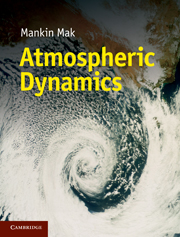Book contents
- Frontmatter
- Contents
- Preface
- 1 Fundamental concepts and physical laws
- 2 Basic approximations and elementary flows
- 3 Vorticity and potential vorticity dynamics
- 4 Friction and boundary layers
- 5 Fundamentals of wave dynamics
- 6 Quasi-geostrophic theory and two-layer model
- 7 Dynamic adjustment
- 8 Instability theories
- 9 Stationary planetary wave dynamics
- 10 Wave-mean flow interaction
- 11 Equilibration dynamics of baroclinic waves
- 12 Nongeostrophic dynamics
- Appendix: Mathematical tools
- References
- Index
- Plate section
8 - Instability theories
Published online by Cambridge University Press: 05 June 2012
- Frontmatter
- Contents
- Preface
- 1 Fundamental concepts and physical laws
- 2 Basic approximations and elementary flows
- 3 Vorticity and potential vorticity dynamics
- 4 Friction and boundary layers
- 5 Fundamentals of wave dynamics
- 6 Quasi-geostrophic theory and two-layer model
- 7 Dynamic adjustment
- 8 Instability theories
- 9 Stationary planetary wave dynamics
- 10 Wave-mean flow interaction
- 11 Equilibration dynamics of baroclinic waves
- 12 Nongeostrophic dynamics
- Appendix: Mathematical tools
- References
- Index
- Plate section
Summary
A general supposition is that the genesis of an atmospheric disturbance is quantitatively understandable in terms of the dynamic instability of a certain background state. There are a number of instability theories in support of this supposition for disturbances of vastly different sizes. To emphasize their distinctiveness as well as interconnectedness, we discuss these theories in four parts (A, B, C and D) of this chapter. Parts A, B and C cover a variety of analyses addressing the instability of different classes of basic shear flows in a dry model setting. In contrast, Part D delineates a type of instability arising from the joint influences of self-induced condensational heating and the basic baroclinicity. A primary focus of most discussions in this chapter is the problem of cyclogenesis in the extratropical atmosphere.
We analyze each type of dynamic instability both as an initial-value problem and as a modal problem. The former would tell us about the characteristics of the transient growth of a disturbance. It would be valuable to be able to establish the analytic necessary condition for modal instability. That however only yields very limited information about the instability. One would still need a modal instability analysis to deduce the number of families of unstable modes and the characteristics of each of those families of modes. The characteristics include the growth rate of each unstable mode, its movement, structure and energetic.
- Type
- Chapter
- Information
- Atmospheric Dynamics , pp. 209 - 308Publisher: Cambridge University PressPrint publication year: 2011
- 1
- Cited by



